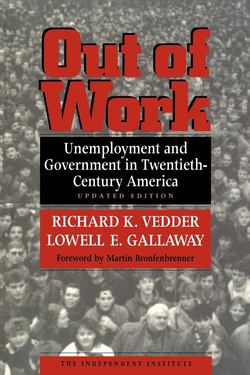Читать книгу Out of Work - Richard K Vedder - Страница 34
На сайте Литреса книга снята с продажи.
EXPANDED LAG STRUCTURE
ОглавлениеIn the process of performing sensitivity analysis such as reported in table 3.2, we experimented with models incorporating more extensive lags than indicated in (4). Perhaps unemployment responds to changes in the components of the adjusted real wage over several years. That indeed is the case. In table 3.3, we report the results of a variant on the original model with some twenty-two explanatory variables. The adjusted real wage variable is lagged some seven years behind the unemployment rate (e.g., unemployment in 1987 is related to the adjusted real wage in 1980.) The relationship between the unemployment rate and the percent change in prices is examined for the current year, and each of the past six years. The same is true of the percent change in labor productivity and percent change in the money wage rate.
TABLE 3.4 TIMING OF UNEMPLOYMENT EFFECTS OF CHANGING WAGES, PRICES AND PRODUCTIVITY
The findings are truly extraordinary. The model explains some 94 percent of the variation in the unemployment rate over time. Of the twenty-two explanatory variables, twenty were statistically significant at the 1 percent level with the expected sign, and the other two, also with the expected sign, were significant at the 2 percent level. In fifty-four of ninety years, the actual unemployment rate was within one percentage point of what the model predicted. Only in one year (1931) did the actual rate deviate from the predicted rate by as much as three percentage points. The model is equally good at predicting at the beginning and at the end of the century. Indeed, the two decades in which the model predicted unemployment within one-half of one percentage point of the actual rate in six or more years were the 1900s and the 1980s.
The results suggest that some of the impact of changing wages, prices, and productivity on unemployment comes long after those variables change, although there is a short-run impact as well. Table 3.4 indicates the proportion of the ultimate effect of changing money wages, prices, and productivity that is observed immediately, after one year, two years, etc. Starting with money-wage changes, the findings suggest that in a year when money wages rise by 1 percent, unemployment rises by 0.16 percent as a consequence. Four years later, this year’s 1 percent wage increase will have an impact on unemployment in that year of 0.64 percentage point. Thus only about 25 percent of the effect of the wage increase is what might be termed “short-run” or immediate, with the remainder coming over time. Note the full (maximum) impact is reached after four years—after that the lagged wage-unemployment relation weakens somewhat.
With productivity change, however, more of the impact comes immediately. A 1 percent productivity increase per worker this year will lower unemployment by 0.48 percentage points. The maximum cumulative impact is reached after three years, 0.77 percentage points. Thus over 60 percent of the productivity-change impact is felt in the year that it occurs. With price changes, the findings are similar. The immediate impact of a 1 percent increase in prices is a fall in the unemployment rate by 0.48 percentage points; the maximum long-term impact, after six years, is 0.67 percentage points, suggesting that about 70 percent of the impact comes immediately.
With all three components of the adjusted real wage, the impact of a change is mostly (85 percent or more of the maximum observed impact) seen within two years. The long-term effect as measured by the maximum regression coefficient runs from a .64 percentage point impact for a 1 percent change in money wages to a .77 percentage point movement for a 1 percent change in labor productivity. The three variables are approximately equal in potency, with the long-term impact somewhat greater than indicated in (4) above, especially for money-wage changes.
